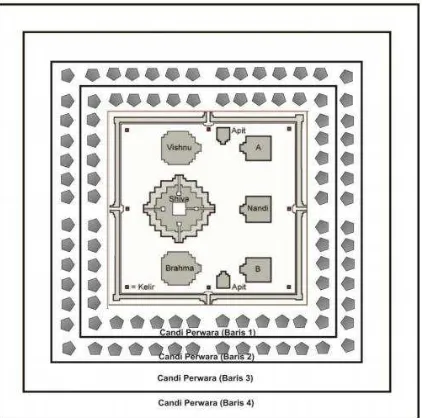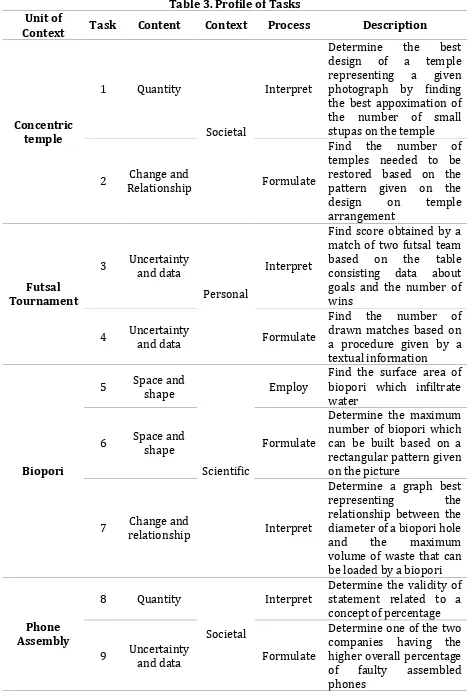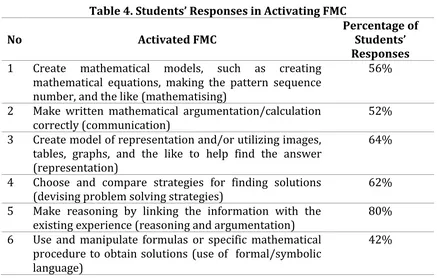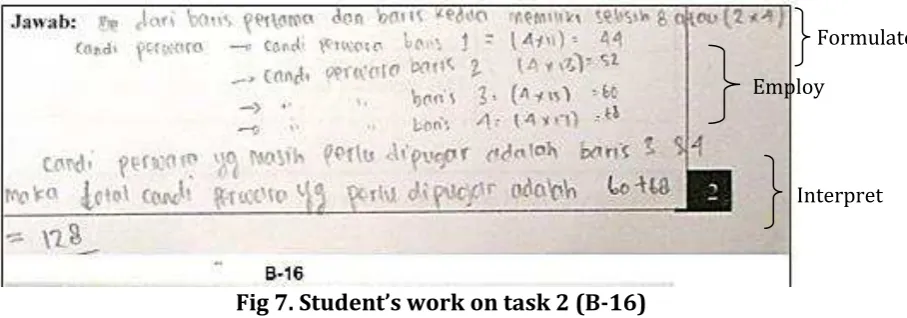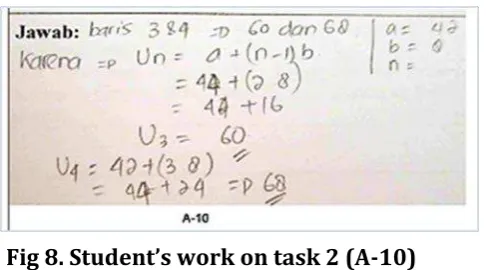DEVELOPING PISA-
like
MATHEMATICS TASKS TO PROMOTE
STUDENTS
’
MATHEMATICAL LITERACY
Ahmad Wachidul Kohar1, Zulkardi, Darmawijoyo
Sriwijaya University
bangwachid@gmail.com1
Abstract
Considering the low performance of Indonesian students in PISA (Programme for International Student Assessment) survey in the period 2000-2012, the need of PISA-like tasks promoting mathematical literacyis important to be developed as learning resource for practisioners. For these reasons, this study aims to produce a set of PISA-like mathematics tasks which are valid, practical, and has the potential effect as well as explain the process of developing those tasks. Thus, we used the preliminary stages, and prototyping using formative evaluation (self evaluation, expert review, one-to-one, small group, and field test). A total of 67 students of senior high school students at Palembang and 12 experts were involved in the prototyping phase. Data collection techniques used are walkthrough, documentation, questionnaire, test results, and interviews. This study produced a set PISA-like math tasks as many as 12 items in the category of content, context, and process. The validity came from the experts who reviewed the prototype at this stage, while the practicality, particularly, obtained from the revised tasks in the steps of both one-to-one and small group . From the field test, we conclude that the tasks also potentially effect to the students mathematical literacy in activating the indicators of each FMC, i.e, communication, reasoning and argumentation, representation, mathematising, problem solving, and using formal/symbolic language and the students interest and seriousness when solving the tasks.
Keywords: PISA-like mathematics task, mathematical literacy, fundamental
mathematical capabilities, mathematical process
INTRODUCTION
mathematically, which is then not followed up on stage to interpret the situation/context of the desired matter. All forms of this weakness seems to be supported by the fact that it is a lot of test material in question in the PISA assessment was not included in the Indonesian mathematics curriculum (Kemdikbud, 2013).
Considering this fact, Indonesia through this moment has been started to implement a new curriculum in 2013 whose framework of its development is encouraged by the PISA result (Kemdikbud, 2013). Consequently, the need of developing learning resources fostering students mathematical literacy is important to be done.Stacey (2013) recommended to conduct study in designing teaching program that uses PISA tasks to improve the quality of mathematics teaching and analyze how students make errors in solving PISA tasks. Meanwhile, Zulkardi (2010) suggest to develop PISA-like mathematics tasks as well as use them in instructional practices. To produce PISA tasks which valid, practical, and has a potential effect, research on developing PISA-like tasks also were conducted by several researchers with a focus on examining the context (Lutfianto, 2012), level (Kamaliyah et al, 2012), and competence (Edo et al, 2013; Novita et al, 2012).
Therefore, this present study aims to produce a set of PISA-like mathematics tasks which are valid, practical , and has potential effect to the development of students mathematical literacy.
THEORETICAL FRAMEWORK Mathematical literacy
One can views mathematical literacy as mathematics which is not only about it as a domain, but also it as application in concrete and practical day-to-day existence (Mbekwa, 2006; Shiel et al, 2007). In PISA 2012, mathematical literacy is defined as an individual s capacity to formulate, employ, and interpret mathematics in a variety of contexts. It includes reasoning mathematically and using mathematical concepts, procedures, facts and tools to describe, explain and predict phenomena. It assists individuals to recognize the role that mathematics plays in the world and to make the well-founded judgments and decisions needed by constructive, engaged and reflective citizens. (OECD, 2013). This definition can then be described into several points, i.e. what kind of problems needed to be solved (challenge in real world context), how mathematical process perform in the solution (mathematical thought and action), and how mathematical competencies are activated in each of the process. See the figure below.
Mathematical literacy starts from real world problems, which are categorized into category of contexts, i.e. personal, occupational, societal, and scientific, and contents, i.e. change and relationship, space and shape, quantity, and uncertainty and data (see OECD, 2013, Stacey, 2011). The process of mathematical literacy begins from identifying the real world problem and formulate the problem mathematically based on the concepts and relationship inherent in the problem. After getting an appropriate mathematical form of the problem, the next step is to employ certain mathematical procedures to obtain mathematical results, which then interpret those back into the initial problem.
The word 'formulate' refers to the ability of individuals to recognize and identify opportunities to use mathematics and then provide mathematical structure for a problem that is presented in some contextual form (OECD, 2013). Meanwhile, OECD (2013) defines word employ as a person's ability to use the concepts, facts, procedures, and reasoning to solve problems that have been formulated to obtain a mathematical conclusion. In the process of employing, mathematical procedures such as arithmetic calculations, a person should show ability of completing the equation, making deductive reasoning of mathematical assumptions, manipulating symbols, filter information contained on the tables and graphs, forming regularity/patterns, identifying relationships in mathematical unity, and making mathematical arguments. Lastly, the word interpret/evaluate reflect a person's ability to interpret solutions, results, or conclusions of mathematical problems in a real-world context.
PISA framework also mentions some competencies that underlie mathematical process performed by a problem solver. Turner, R (2012) mentions seven fundamental mathematical capabilities that underlie a person's knowledge and skills in using mathematics effectively.
1. Communication, covers reading, decoding and interpreting statements, questions, tasks or objects enables the individual to form a mental model of the situation (receptive component); presenting answers or justification of the statement provided.
2. Reasoning and argumentation, thinking logically that explore and link the elements of the problem so that can make inferences from these elements, examine the justification given, or provide justification to solutions or statements of the problems. 3. Mathematising, covers transforming a problem defined in the real world to a strictly
mathematical form (which can include structuring, conceptualising, making assumptions, and/or formulating a model), or interpreting or evaluating a mathematical outcome or a mathematical model in relation to the original problem. 4. Representation, selecting, interpreting, translating between, and using a variety of
representations (e.g. graphs, tables, diagrams, pictures, equations, formulae, and concrete materials) to capture a situation or interact with the problem.
5. Devising problem solving strategies, covers selecting or devising a plan or strategy to use mathematics to solve problems arising from a task or context, as well as guiding its implementation.
conventions and rules; understanding and utilising constructs based on definitions, rules and formal systems.
METHOD
This is a designresearch using the type of development study. The emphasis of this study is on iterative development with formative evaluation in various user settings (Plomp, T., & Nieveen, N, 2007).The formative evaluation consisted of preliminary stage and prototyping phase which includes self evaluation, expert reviews and one-to-one, small group, and a field test (Tessmer, 1993, Zulkardi 2002).
Fig 2. Formative Evaluation (Adopted from Tessmer, 1993; Zulkardi, 2002)
The development process started from preliminary step by grasping with the concept related to developing mathematical literacy tasks then used it to design an initial prototype. This prototype was then self-evaluated before entering the next steps. In expert review, twelve experts were involved to validate the tasks in terms of content
(satisfied framework of PISA 2012), construct develop students mathematical literacy ,
and language (grammatical error, obvious limitiation of questions and
answers).Simultaneouly with expert review, 4 students in one-to-one validation evaluate particularly on how they understand the information e.g. picture, phrase, etc in the tasks and not focus on how they answer the tasks. These results gave important suggestions to revise the tasks so that those could be re-evaluated in small group. The smallgroup phase involved 12 students with various academic abilities to solve the tasks in 90 minutes. Here, we firstly obtained students performance in solving the tasks because we scored and analyzed a variety of student s answer. We used this data as a view to assess student s real performance in larger test, i.e. field test. Meanwhile, the field test was conducted on 50 students aged maximum 16 years 2 months from a senior high school at Palembang.
RESULT AND DISCUSSION Developing tasks
and an Indonesian PISA wes (Ariyadi Wijaya, M.Sc). The following is one of tasks example on this situation.
Before revision
Fig 3. Task 1 before revision
Table 1. Comments from Experts and Students on task 1 Valid the context. question 1 is good. Maybe you should tell students whether they have to be exact or approximate. I expected to give an approximate answer – in fact students do not really know they are symmetric, so it can only be an estimate. you will need to think about the best wording in bahasa.
Clarify the picture by enlarging photo size
One
-to
-on
e
I do not know the exact number of stupas on the back. If there is an additional information about the symmetrical arrangement of the stupa or something like that, surely it will help my calculations.
Add information that
the stupas are
arranged
concentrically which is put in the general information.
The picture was then
enlarged. The picture less clear, enlarge the picture
After obtaining some suggestions from both experts and students, the prototype 1 was revised become prototype 2. The following is the revised tasks based on the table 1.
After revision
Now, we will see another task which is still in same context with the task above.
Before revision
Fig 5. task 2 before revision
Table 2. Comments from Experts and Students on task 2 Valida
tion Comments/Suggestion Decision for Revision
Ex
per
t Revi
ew
The task is dependent with the previous task. Here you have a problem of question independence. You cannot Offering new idea of changing content of question: I m
thinking of a different question – just an idea, it might be too difficult, and it might be too difficult to code the responses. At another historic site, a similar structure has four rings of stupas containing, respectively, 12, 20, 28 and 36 stupa. Give a mathematical argument to explain why it is that this sequence of numbers increases in steps of the same amount. [I try to get around the independence issue by using the same kind of context, but shifting it a little to a different location. I admit that this might not be realistic.]
The task is less contextual
One
-to
-on
e The solution of the answers depend on answers on task
After revision
Fig 6. Task 2 after revision
Table 3. Profile of Tasks Unit of
Context Task Content Context Process Description
Archery
The purpose of the field test was to find out the potential effects of the tasks on students' mathematical literacy. After the students completed work on the tasks, we gave questionnaires to all students, and interviewed 6 students to obtain data about the potential effects. To discuss the potential effects, we compared the results of students responses on the written questionnaire regarding the questions 1 (fundamental mathematical capabilities/FMC), questions 2 (students interest and seriousness on the tasks), questions 3 (general impression on the tasks), and interviews.
The students responses on the questionnaire is shown below.
Table . Students’ Responses in Activating FMC
No Activated FMC
Percentage of
Students’
Responses
1 Create mathematical models, such as creating
mathematical equations, making the pattern sequence number, and the like (mathematising)
56%
2 Make written mathematical argumentation/calculation
correctly (communication)
52%
3 Create model of representation and/or utilizing images,
student 2 : The tasks require more reasoning. It is different with what I used to solve, where the qonly ask me to use an available formula. it is good to train my thinking.
Furthermore, the potential effect of the tasks is also seen from the extent to which students are interested and serious in solving the tasks. The data supporting students responses on the tasks are given in the following table.
Table . Students’ Responses on Prototype
How interesting are the tasks? Students’ ResponsePercentage of
I am interested and serious in working all the tasks 34%
I am only interested and serious in working certain tasks
64%
I am intereseted, but not serious in working the tasks 0%
I am not interested in the tasks at all 2%
As a proof how students activate their FMC into mathematical process: formulate, employ, interpret in solving the tasks, the following are examples of students work on task 2.The aim of the task is to examine students ability in observing empirically the pattern of arrangement of temple on certain rows. (see fig )
Fig . Student’s work on task (B-16)
Answer of student B-16 above shows activation on FMC in his work. The
studentinvolved constructive communications by writing the result of inductive
reasoning process to show that the difference between the number of temples on each two rows is 8 units. This idea can be seen as an interpretation which is based on the observation of the pictorialrepresentation, namely the design of the temple arrangement. In terms of the process involved, it can be said that this activity is done as a manifestation of the process of formulating. Meanwhile, at the time of employing,the student executeproblem solving strategy by listing the number of temples in each row then realized that there is a regularity of arrangement of temples on each side of the row. Therefore, it can be concluded that the number of temples on each side are same. This idea was used to write the number of temples on the 3rd row and 4th as (4x15) and (4x17) consecutively because there are 4 sides on each row. Meanwhile, another different idea was expressed by student 2 by using the arithmetic sequence formula in finding the solution. The following shows this idea.
Formulate
Employ
Fig . Student’s work on task (A-10)
In terms of FMC involved, student A-10 implementedher strategy to perform the use of
symbolic/simple algebraic operations by linking the regularity of the form of the temple with a scheme that has been learned about the formula of arithmetic sequence. In representing solution, he was able to identify that the number of temples in the first row and the second row can be seen as the first and second terms in arithmetic sequence, in order to obtain the value of first term, a = 44 and different, b = 8. This activity continues to perform substitution value of n, which shows a sequence of rows into a formula that has been constructed to determine the number of temples in the 3rd row and 4th row. However, from the picture it appears that A-10 has not added up the number of temples on in the 3rd row and 4th. Here, we find incomplete steps performed by students in solving the task.
CONCLUSION
This study produced set of PISA-like mathematics tasks which are valid, practical. Based on the results, prototype 3 has potential effect to develop students mathematical literacy, shown by their activation of FMC into each of mathematical processs: formulate, employ, and interpret, Other indications of this effect are also seen from their seriousness and interest when solving the tasks. Lastly, we suggest teachers and other practisioners to use the tasks from this study as tools in designing PISA problem based learning as well as design and evaluate tasks which satisfy the characteristics of mathematical literacy as mentioned in PISA framework.
REFERENCES
Edo, S.)., (artono, Y., & Putri, R.). . )nvestigating Secondary School Student s
Difficulties in Modelling Problems PISA-Model Level 5 and 6, Journal on
Mathematics Education (IndoMS-JME), 4(1), 41-58.
Jupri, A., Drijvers, P., & van den Heuvel-Panhuizen, M. (2014). Difficulties in initial algebra learning in Indonesia, Mathematics Education Research Journal, 1-28. doi: 10.1007/s13394-013-0097-0
Kamaliyah., Zulkardi., & Darmowijoyo. (2013). Developing the Sixth Level of PISA-Like Mathematics Problems for Secondary School Students,Journal on Mathematics Education (IndoMS-JME), 4(1), 9-28.
Kemdikbud. (2013). Kerangka Dasar dan Struktur Kurikulum Sekolah Menengah Atas/Madrasah Aliyah dalam Lampiran Permendikbud No 69 Tahun 2013. Jakarta: Kemendikbud.
Kemdikbud. (2013). Pengembangan Kurikulum 2013, Paparan Menteri Pendidikan dan
Kebudayaan RI. Makalah dipresentasikan di Semarang, 4 Mei 2013.
Lutfianto, M., Zulkardi, & Hartono, Y. (2013). Unfinished Student Answer In PISA Mathematics Contextual Problem,Journal on Mathematics Education (IndoMS-JME), 4(2), 201-208.
Mbekwa, M. (2006). Teachers' views on mathematical literacy and on their experiences as students of the course. Pythagoras, (63), 22-29.
Novita, R., Zulkardi, & (artono, Y. . Exploring Primary Student s Problem-Solving Abilityby Doing Tasks Like P)SA s Question,Journal on Mathematics Education (IndoMS-JME), 3(2), 133-150.
OECD. (2013). PISA 2012 Assessment and Analytical Framework: Mathematics, Reading, Science, Problem Solving and Financial Literacy. Paris: OECD Publishing.
Shiel, G., Perkins, R., Close, S.,& Oldham, E. (2007). PISA Mathematics: A Teacher s Guide. Dublin: Stationery Office.
Stacey, K. (2011). The PISA View of Mathematical Literacy in Indonesia, Journal on Mathematics Education (IndoMS-JME), 2(2),95-126..
Stacey, K. (2010). Mathematical and Scientific Literacy Around The World. Journal of Science and Mathematics Education in Southeast Asia, 33(1), 1-16.
Stacey, K. (2013). PISA 2012: Philosophy, Item Development, Success and Possible Research. Makalah dipresentasikan di kuliah umum Pascasarjana Universitas Negeri Malang, Rabu, 26 Juni 2013.
Turner, R. (2009). Using Mathematical Competencies to Predict Item Difficulty in PISA,
PISA Research Conference, retrieved from


